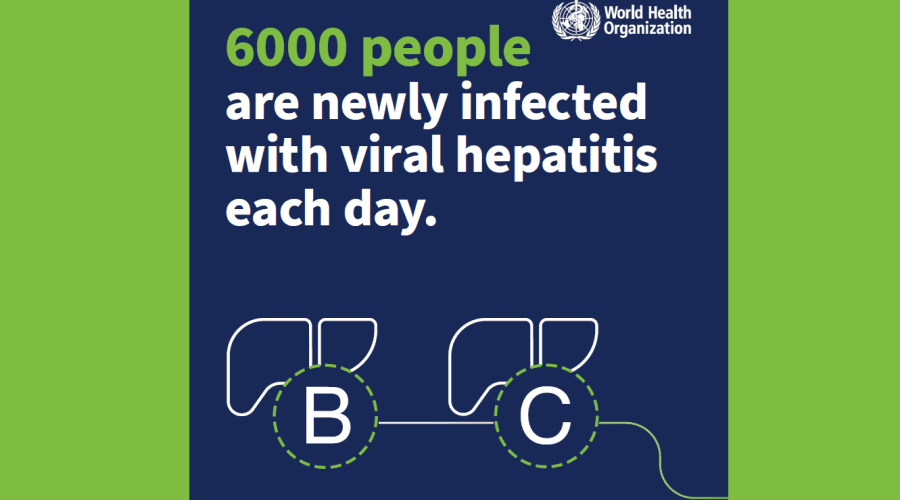 Credit: WHO
Credit: WHO28 July 2025 — As we mark World Hepatitis Day, WHO calls on governments and partners to urgently accelerate efforts to eliminate viral hepatitis as a public health threat and reduce liver cancer deaths.
“Every 30 seconds, someone dies from a hepatitis-related severe liver disease or liver cancer. Yet we have the tools to stop hepatitis,” said Dr Tedros Adhanom Ghebreyesus, WHO Director-General.
Viral hepatitis – types A, B, C, D, and E – are major causes of acute liver infection. Among these only hepatitis B, C, and D can lead to chronic infections that significantly increase the risk of cirrhosis, liver failure, or liver cancer. Yet most people with hepatitis don’t know they’re infected. Types B, C, and D affect over 300 million people globally and cause more than 1.3 million deaths each year, mainly from liver cirrhosis and cancer.
Hepatitis D now classified as carcinogenic
The International Agency for Research on Cancer (IARC) recently classified hepatitis D as carcinogenic to humans, just like hepatitis B and C. Hepatitis D, which only affects individuals infected with the hepatitis B, is associated with a two- to six-fold higher risk of liver cancer compared to hepatitis B alone. This reclassification marks a critical step in global efforts to raise awareness, improve screening, and expand access to new treatments for hepatitis D.
“WHO has published guidelines on testing and diagnosis of Hepatitis B and D in 2024, and is actively following the clinical outcomes from innovative treatments for hepatitis D,” said Dr Meg Doherty, incoming Director of Science for Health at WHO.
Treatment with oral medicine can cure hepatitis C within 2 to 3 months and effectively suppress hepatitis B with life-long therapy. Treatment options for hepatitis D are evolving. However, the full benefit of reducing liver cirrhosis and cancer deaths can only be realized through urgent action to scale up and integrate hepatitis services – including vaccination, testing, harm reduction, and treatment – into national health systems.
Latest data and progress
Encouragingly, the majority of low- and middle-income countries (LMICs) have strategic plans on hepatitis in place and progress in national hepatitis responses is increasing:
- in 2025, the number of countries reporting national hepatitis action plans increased from 59 to 123;
- as of 2025, 129 countries have adopted policies for hepatitis B testing among pregnant women, up from 106 reported in 2024; and
- 147 countries have introduced the hepatitis B birth dose vaccination, an increase from 138 in 2022.
However, critical gaps remain in service coverage and outcomes, as stated in the 2024 Global Hepatitis Report:
- testing and treatment coverage remain critically low; only 13% of people with hepatitis B and 36% with hepatitis C had been diagnosed by 2022;
- treatment rates were even lower – 3% for hepatitis B and 20% for hepatitis C – well below the 2025 targets of 60% diagnosed and 50% treated; and
- integration of hepatitis services remains uneven: 80 countries have incorporated hepatitis services into primary health care; 128 into HIV programmes and just 27 have integrated hepatitis C services into harm reduction centres.The next challenge will be to scale up the implementation of prevention, testing and treatment coverage. Achieving WHO’s 2030 targets could save 2.8 million lives and prevent 9.8 million new infections. With declining donor support, countries must prioritize domestic investment, integrated services, better data, affordable medicines, and ending stigma.
Forging new partnerships
To mark World Hepatitis Day, WHO is partnering with Rotary International and the World Hepatitis Alliance to strengthen global and local advocacy. This year’s campaign “Hepatitis: Let’s break it down” demands action to confront the rising toll of liver cancer linked to chronic hepatitis infections. It also calls for decisive steps to dismantle persistent barriers – from stigma to funding gaps – that continue to slow progress in prevention, testing, and treatment.
Access all related materials here.
Source : World Health Organization
Related HIV and Co-Infections News
Get involved
Are you living with HIV/AIDS? Are you part of a community affected by HIV/AIDS and co-infections? Do you work or volunteer in the field? Are you motivated by our cause and interested to support our work?
Subscribe
Stay in the loop and get all the important EATG updates in your inbox with the EATG newsletter. The HIV & co-infections bulletin is your source of handpicked news from the field arriving regularly to your inbox.
